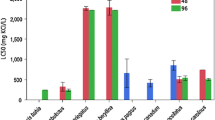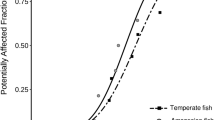Abstract
As part of the ecological risk assessment for Portland Harbor Superfund site, a study was conducted to address the question of whether the use of surrogate species in the risk assessment would be protective of lamprey ammocoetes. The study evaluated the acute toxicity of six chemicals: pentachlorophenol, copper, diazinon, aniline, naphthalene, and lindane; these chemicals represent the toxic modes of action of oxidative phosphorylation uncoupler, gill dysfunction, acetylcholinesterase inhibitor, polar narcosis, narcosis, and central nervous system interference, respectively. Field-collected lamprey ammocoetes were exposed to each of the six chemicals in a definitive 96-h flow-through acute water-only toxicity test. LC50s were calculated for pentachlorophenol at 31 μg/l, copper at 46 μg/l, diazinon at 8.9 mg/l, and aniline at 430 mg/l. Species sensitivity distributions based on LC50s for aquatic organisms indicated that lamprey ammocoetes were relatively sensitive to pentachlorophenol (15th percentile). The sensitivity of lamprey ammocoetes to copper approximated the average of aquatic species tested (46th percentile). Lamprey ammocoetes were relatively insensitive to diazinon and aniline (72th and 90th percentile, respectively). The 96-h LC50 for naphthalene was estimated at 10 mg/l, based on 50% mortality in the highest concentration. Based on a comparison with LC50s for four other fish species, ranging from 2.0 to 6.6 mg/l, lamprey ammocoetes were relatively insensitive to naphthalene. A 96-h LC50 could not be derived for lindane, with 12.5% mortality in the highest test concentration of 2.68 mg/l. LC50s for numerous other fish species ranged from 0.001 to 0.24 mg/l, indicating that lamprey ammocoetes were relatively insensitive to lindane. The study concluded that the use of surrogate species in the ecological risk assessment for Portland Harbor would be protective of lamprey ammocoetes.




Similar content being viewed by others
Notes
The Willamette River is within the documented distribution range of Pacific lamprey (E. tridentatus) and western brook lamprey (L. richardsoni) (Kostow 2002). Pacific brook lamprey (L. pacifica) have been collected from the Willamette River; however, the validity of recognizing this as a separate species has been questioned (Kostow 2002). River lamprey (L. ayresii) might exist in the Willamette River; however, this species has not been documented in Oregon since 1980 (Alaska Natural Heritage Program 2005).
Other investigators are in the process of conducting pilot studies to develop sediment toxicity testing methods for lamprey (NOAA 2009).
References
Alaska Natural Heritage Program (2005) Fishes tracking list and status reports: river lamprey (Lampetra ayresii). Alaska Natural Heritage Program, Environment and Natural Resources Institute, University of Alaska, Anchorage
Aldegunde M, Soengas JL, Ruibal C, Andrés MD (1999) Effects of chronic exposure to γ-HCH (Lindane) on brain serotonergic and gabaergic systems, and serum cortisol and thyroxine levels of rainbow trout, Onchorynchus mykiss. Fish Physiol Biochem 20:325–330
Applegate VC, Howell JH, Hall AE, Smith MA (1957) Toxicity of 4,346 chemicals to larval lampreys and fishes. Special scientific report, Fisheries No. 207. US Department of the Interior, Fish and Wildlife Service, Washington, DC
ASTM (1996) Standard guide for conducting acute toxicity tests on test materials with fishes, macroinvertebrates, and amphibians. E729-96. American Society for Testing and Materials, Philadelphia
Bearden AP, Schultz TW (1997) Structure-activity relationships for Pimephales and Tetrahymena: a mechanism of action approach. Environ Toxicol Chem 16(6):1311–1317
Benoit DV, Mattson VR, Olson DL (1982) A continuous-flow mini-diluter system for toxicity testing. Water Resour 16:457–464
Biggar JW, Donnen LD, Riggs RL (1968) Soil interaction with organically polluted water. Summary report. Department of Water Science and Engineering, University of California (1966) cf. FA Gunther, WE Westlake, PS Jaglan. Residue Rev 20: 1. Cited in Aquasol Database of Aqueous Solubility, University of Arizona College of Pharmacy, Tucson
Bogdanova A, Sherstobitov AO, Gusev GP (1998) Chloride transport in red blood cells of lamprey Lampetra fluviatilis: evidence for a novel anion-exchange system. J Exp Biol 201:693–700
Bogdanova A, Virkki LV, Gusev GP, Nikinmaa M (1999) Copper effects on ion transport across lamprey erythrocyte membrane: Cl−/OH− exchange induced by cuprous ions. Toxicol Appl Pharmacol 159(3):204–213
Broderius SJ, Kahl MD, Elonen GE, Hammermeister DE, Hoglund MD (2005) A comparison of the lethal and sublethal toxicity of organic chemical mixtures to the fathead minnow (Pimephales promelas). Environ Toxicol Chem 24(12):3117–3127
Dawson VK, Cumming KB, Gilderhus PA (1975) Laboratory efficacy of 3-trifluoromethyl-4-nitrophenol (TFM) as a lampricide. Investigations in Fish Control No. 63. US Fish and Wildlife Service, US Department of the Interior, Washington, DC
Dawson VK, Cumming KR, Gilderhus PA (1977) Efficacy of 3-trifluoromethyl-4-nitrophenol (TFM), 2′, 5-dichloro-4′-nitrosalicylanilide (Bayer 73), and a 98:2 mixture as lampricides in laboratory. Investigations in Fish Control No. 77. Fish and Wildlife Service, US Department of the Interior, Washington, DC
Denton DL et al (2003) Joint acute toxicity of esfenvalerate and diazinon to larval fathead minnows (Pimephales promelas). Environ Toxicol Chem 22(2):336–341
EPA (US Environmental Protection Agency) (1980a) Ambient water quality criteria for hexachlorocyclohexane. EPA 440/5–80-054. EPA, Washington, DC
EPA (US Environmental Protection Agency) (1980b) Ambient water quality criteria for naphthalene. EPA 440/5–80-059. EPA, Washington, DC
EPA (US Environmental Protection Agency) (1986) Ambient water quality criteria for pentachlorophenol—1986. EPA 440/5–86-009. EPA, Washington, DC
EPA (US Environmental Protection Agency) (1993) Ambient water quality criteria for aniline. Draft. 822R93024. Office of Water, Washington, DC
EPA (US Environmental Protection Agency) (1994a) Method 200.8. Determination of trace elements in waters and wastes by inductively coupled plasma-mass spectrometry. Rev. 5.4. In: Test methods for evaluating solid waste, physical/chemical methods SW-846. EPA, Washington, DC
EPA (US Environmental Protection Agency) (1994b) Method 8141A. Organophosphorus compounds by gas chromatography: capillary column technique. Rev. 1. In: Test methods for evaluating solid waste, physical/chemical methods, SW-846. EPA, Washington, DC
EPA (US Environmental Protection Agency) (1996a) Method 3005A. Acid digestion of waters for total recoverable or dissolved metals for analysis by FLAA or ICP spectroscopy. Rev. 3. In: Test methods for evaluating solid waste, physical/chemical methods, SW-846. EPA, Washington, DC
EPA (US Environmental Protection Agency) (1996b). Method 3520C. Continuous liquid-liquid extraction. Rev. 3. In: Test methods for evaluating solid waste, physical/chemical methods, SW-846. EPA, Washington, DC
EPA (US Environmental Protection Agency) (1996c) Method 3535. Solid-phase extraction. In: Test methods for evaluating solid waste, physical/chemical methods SW-846. EPA, Washington, DC
EPA (US Environmental Protection Agency) (1996d) Method 5035. Closed-system purge-and-trap and extraction for volatile organics in soil and waste samples. In: Test methods for evaluating solid waste, physical/chemical methods, SW-846. EPA, Washington, DC
EPA (US Environmental Protection Agency) (1996e) Method 8081A. Organochlorine pesticides by gas chromatography. Rev. 1. In: Test methods for evaluating solid waste, physical/chemical methods, SW-846. EPA, Washington, DC
EPA (US Environmental Protection Agency) (1996f) Method 8151A. Chlorinated herbicides by GC using methylation or pentafluorobenzylation derivatization. Rev. 1. In: Test methods for evaluating solid waste, physical/chemical methods, SW-846. EPA, Washington, DC
EPA (US Environmental Protection Agency) (1996g) Method 8260B. Volatile organic compounds by gas chromatography/mass spectrometry (GC/MS). Rev. 2. In: Test methods for evaluating solid waste, physical/chemical methods, SW-846. EPA, Washington, DC
EPA (US Environmental Protection Agency) (1996h) Method 8270C. Semivolatile organic compounds by gas chromatography/mass spectrometry (GC/MS). Rev. 3. In: Test methods for evaluating solid waste, physical/chemical methods, SW-846. EPA, Washington, DC
EPA (US Environmental Protection Agency) (2002) Methods for measuring the acute toxicity of effluents and receiving waters to freshwater and marine organisms, 5th edn. EPA-821-R-02–012. Office of Water, Washington, DC
EPA (US Environmental Protection Agency) (2005) Ambient water quality criteria: diazinon. EPA 822/R-05–006. Office of Water, Washington, DC
EPA (US Environmental Protection Agency) (2007a) EPA e-mail dated December 27, 2007 (B. Shephard to J. Toll, Windward Environmental) regarding lamprey toxicity relative to other species with attached Excel file. Region 10, Seattle, WA
EPA (US Environmental Protection Agency) (2007b) Table 1. Acute toxicity of copper to freshwater animals. In: Aquatic life ambient freshwater quality criteria—copper, 2007 revision. EPA-822-R-07–001. Office of Water, Washington, DC
EPA (US Environmental Protection Agency) (2008) EPA e-mail dated May 30, 2008 (B. Shephard to J. Toll, Windward Environmental) regarding unpublished naphthalene LC50 data with attached Excel file. Region 10, Seattle, WA
Gold G, Rodriquez S (1989) The effect of temperature and salinity on the Setschenow parameters of naphthalene in seawater. Can J Chem 67:822–826
Goodman DH, Reid SB, Docker MF, Haas GR, Kinziger AP (2008) Mitochondrial DNA evidence for high levels of gene flow among populations of a widely distributed anadromous lamprey Entosphenus tridentatus (Petromyzontidae). J Fish Biol 72:400–417
Integral, Windward, Kennedy/Jenks, Anchor, Groundwater Solutions (2004) Portland Harbor RI/FS programmatic work plan. Prepared for Lower Willamette Group. Integral Consulting, Inc., Mercer Island, Washington; Windward Environmental LLC, Seattle, Washington; Kennedy/Jenks Consultants, Portland, Oregon; Anchor Environmental, LLC, Seattle, Washington; Groundwater Solutions, Inc., Portland, Oregon
Ivanov KA (1956) Solubility of Lindane in H2O. Gigiena Sanitariya 21:82–83. (Cited in Aquasol Database of Aqueous Solubility, University of Arizona College of Pharmacy)
King EL Jr, Gabel JA (1985) Comparative toxicity of the lampricide 3-trifluoromethyl-4-nitrophenol to ammocetes of three species of lampreys. Great Lakes Fishery Commission Technical Report No. 47. Great Lakes Fishery Commission, Ann Arbor, MI, pp 1–5
Kostow K (2002) Oregon lampreys: natural history status and analysis of management issues. Oregon Department of Fish and Wildlife, Portland, OR
Lech JJ, Statham CN (1975) Role of glucuronide formation in the selective toxicity of 3-trifluoromethyl-4-nitrophenol (TFM) for the sea lamprey: comparative aspects of TFM. Toxicol Appl Pharmacol 31(1):150–158
Mallatt J, Barron MG (1988) High tolerance of lampreys to kepone toxicity. Arch Environ Contam Toxicol 17(1):73–80
Mallatt J, Barron MC, McDonough C (1986) Acute toxicity of methyl mercury to the larval lamprey, Petromyzon marinus. Bull Environ Contam Toxicol 37(2):281–288
Marking LL, King EL, Walker CR, Howell JH (1970) Toxicity of 33NCS (3′-chloro-3-nitrosalicylanilide) to freshwater fish and sea lamprey. Investigations in Fish Control 38. US Fish and Wildlife Service, US Department of the Interior, Washington, DC
McKim JM, Schmeieder PK, Carlson RW, Hunt EP, Niemi GJ (1987) Use of respiratory-cardiovascular responses of rainbow trout (Salmo gairdneri) in identifying acute toxicity syndromes in fish: part 1. Pentachlorophenol, 2, 4-dinitrophenol, tricaine methanesulfonate and 1-octanol. Environ Toxicol Chem 6:295–312
Niblett PD, Ballantyne JS (1976) Uncoupling of oxidative phosphorylation in rat liver mitochondria by the lamprey larvicide TFM (3-trifluoromethyl-4-nitrophenol). Pestic Biochem Physiol 6:363–366
NOAA (National Oceanic and Atmospheric Administration) (2009) Personal communication between Helle Andersen, Windward Environmental LLC, and Robert Neely, Regional Resources Coordinator, NOAA Ocean Services, December 16, 2009
Piavis GW, Howell JH (1975) Effects of 3-trifluoromethyl-4-nitrophenol (TFM) on developmental stages of the sea lamprey. Investigations in Fish Control No. 64. US Fish and Wildlife Service, US Department of the Interior, Washington, DC
Scholefield RJ, Seelye JG (1992) Toxicity of 2′,5-dichloro-4′-nitrosalicylanilide (Bayer 73) to three genera of larval lampreys. Great Lakes Fishery Commission Technical Report No. 57. Great Lakes Fishery Commission, Ann Arbor, MI, pp 1–6
Scholefield RJ, Seelye JG, Slaght KS (1995) Comparison of 3-trifluoromethyl-4-nitrophenol (TFM) toxicities to sea lampreys, rainbow trout, and mayfly nymphs in continuous and interrupted 9-h exposures. Great Lakes Fishery Commission Technical Report No. 61. Great Lakes Fishery Commission, Ann Arbor, MI, pp 9–31
Vaes WHJ, Ramos EU, Verhaar HJM, Hermens LM (1998) Acute toxicity of nonpolar versus polar narcosis: is there a difference? Environ Toxicol Chem 17(7):1380–1384
van Dewetering S (2009) Personal communication between S. van Dewetering, Siletz Tribal Fisheries Biologist, and H. Andersen, Windward Environmental LLC. October 16, 2009
Veith GD, Comstock VM (1975) Apparatus for continuously saturating water with hydrophobic organic chemicals. J Fish Bd Can 32:1849–1851
Wood CM (2001) Toxic responses of the gill. In: Schleck D, Benson WH (eds) Target organ toxicity in marine and freshwater teleosts. Taylor & Francis, London, pp 1–87
Acknowledgment
This work was funded by the Lower Willamette Group. The manuscript represents the work of the authors and does not represent the position of the Lower Willamette Group or its members.
Author information
Authors and Affiliations
Corresponding author
Rights and permissions
About this article
Cite this article
Andersen, H.B., Caldwell, R.S., Toll, J. et al. Sensitivity of Lamprey Ammocoetes to Six Chemicals. Arch Environ Contam Toxicol 59, 622–631 (2010). https://doi.org/10.1007/s00244-010-9514-5
Received:
Accepted:
Published:
Issue Date:
DOI: https://doi.org/10.1007/s00244-010-9514-5




